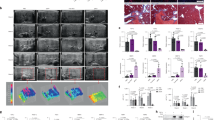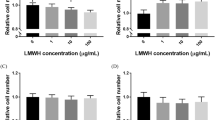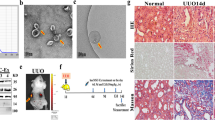Abstract
We sought to investigate the antifibrotic effects of an artificial microRNA (miRNA) targeting connective tissue growth factor (CTGF) using the ultrasound-targeted cationic liposome-bearing microbubble destruction gene delivery system. Cationic liposomes were conjugated with microbubbles using a biotin–avidin system. Plasmids carrying the most effective artificial miRNA sequences were delivered by ultrasound-targeted cationic liposome-bearing microbubble destruction gene delivery system to rats with hepatic fibrosis. The results show that this method of gene delivery effectively transported the plasmids to the rat liver. The artificial miRNA reduced hepatic fibrosis pathological alterations as well as the protein and mRNA expressions of CTGF and transforming growth factor β1. Furthermore, the CTGF gene silencing decreased the levels of type I collagen and α-smooth muscle actin (P<0.01). These data suggest that delivery of an artificial miRNA targeted against CTGF using ultrasound-targeted cationic liposome-bearing microbubble destruction may be an efficacious therapeutic method to ameliorate hepatic fibrosis.
This is a preview of subscription content, access via your institution
Access options
Subscribe to this journal
Receive 12 print issues and online access
$259.00 per year
only $21.58 per issue
Buy this article
- Purchase on Springer Link
- Instant access to full article PDF
Prices may be subject to local taxes which are calculated during checkout







Similar content being viewed by others
References
Hernandez-Gea V, Friedman SL . Pathogenesis of liver fibrosis. Annu Rev Pathol 2011; 6: 425–456.
Lee UE, Friedman SL . Mechanisms of hepatic fibrogenesis. Best Pract Res Clin Gastroenterol 2011; 25: 195–196.
Jiao J, Friedman SL, Aloman C . Hepatic fibrosis. Curr Opin Gastroenterol 2009; 25: 223–229.
Cheng K, Yang N, Mahato RI . TGF-beta1 gene silencing for treating liver fibrosis. Mol Pharm 2009; 6: 772–779.
Sisco M, Kryger ZB, O'Shaughnessy KD, Kim PS, Schultz GS, Ding XZ et al. Antisense inhibition of connective tissue growth factor (CTGF/CCN2) mRNA limits hypertrophic scarring without affecting wound healing in vivo. Wound Repair Regen 2008; 16: 661–673.
Gao RP, Brigstock DR . Connective tissue growth factor hammerhead ribozyme attenuates human hepatic stellate cell function. World J Gastroenterol 2009; 15: 3807–3813.
Huang G, Brigstock DR . Regulation of hepatic stellate cells by connective tissue growth factor. Front Biosci 2012; 17: 2495–2497.
Li G, Li D, Xie Q, Shi Y, Jiang S, Jin Y . RNA interfering connective tissue growth factor prevents rat hepatic stellate cell activation and extracellular matrix production. J Gene Med 2008; 10: 1039–1047.
Zhang D, Wang NY, Yang CB, Fang GX, Liu W, Wen J et al. The clinical value of serum connective tissue growth factor in the assessment of liver fibrosis. Dig Dis Sci 2010; 55: 767–774.
George J, Tsutsumi M . siRNA-mediated knockdown of connective tissue growth factor prevents N-nitrosodimethylamine—induced hepatic fibrosis in rats. Gene Ther 2007; 14: 790–803.
Li G, Xie Q, Shi Y, Li D, Zhang M, Jiang S et al. Inhibition of connective tissue growth factor by siRNA prevents liver fibrosis in rats. J Gene Med 2006; 8: 889–900.
Roderburg C, Urban GW, Bettermann K, Vucur M, Zimmermann H, Schmidt S et al. Micro-RNA profiling reveals a role for miR-29 in human and murine liver fibrosis. Hepatology 2011; 53: 209–218.
Maubach G, Lim MC, Chen J, Yang H, Zhuo L . miRNA studies in vitro and in vivo activated hepatic stellate cells. World J Gastroenterol 2011; 17: 2748–2773.
Hu T, Fu Q, Chen P, Ma L, Sin O, Guo D . Construction of an artificial MicroRNA expression vector forsimultaneous inhibition of multiple genes in mammalian cells. Int J Mol Sci 2009; 10: 2158–2168.
Baek MN, Jung KH, Halder D, Choi MR, Lee BH, Jung MH et al. Artificial microRNA-based neurokinin-1 receptor gene silencing reduces alcohol consumption in mice. Neurosci Lett 2010; 475: 124–128.
Fan ZD, Zhang L, Gan XB, Gao XY, Zhu GQ . Artificial microRNA interference targeting AT(1a) receptors in paraventricular nucleus attenuates hypertension in rats. Gene Therapy 2011; 19: 810–817.
Suzuki R, Oda Y, Utoguchi N, Maruyama K . Progress in the development of ultrasound-mediated gene delivery systems utilizing nano- and microbubbles. J Control Release 2011; 149: 36–41.
Mayer CR, Geis NA, Katus HA, Bekeredjian R . Ultrasound targeted microbubble destruction for drug and gene delivery. Expert Opin Drug Deliv 2008; 5: 1121–1138.
Bekeredjian R, Chen S, Frenkel PA, Grayburn PA, Shohet RV . Ultrasound-targeted microbubble destruction can repeatedly direct highly specific plasmid expression to the heart. Circulation 2003; 108: 1022–1026.
Kheirolomoom A, Dayton PA, Lum AF, Little E, Paoli EE, Zheng H et al. Acoustically-active microbubbles conjugated to liposomes: characterization of a proposed drug delivery vehicle. J Control Release 2007; 118: 275–284.
Vandenbroucke RE, Lentacker I, Demeester J, De Smedt SC, Sanders NN . Ultrasound assisted siRNA delivery using PEG-siPlex loaded microbubbles. J Control Release 2008; 126: 265–273.
Yang D, Tan KB, Gao YH, Liu H, Yang WX . Effects of diagnostic ultrasound-targeted microbubble destruction on permeability of normal liver in rats. Ultrasonics 2012; 52: 1065–1071.
Mingozzi F, High KA . Immune responses to AAV in clinical trials. Curr Gene Ther 2011; 11: 321–330.
Chen SW, Zhang XR, Wang CZ, Chen WZ, Xie WF, Chen YX . RNA interference targeting the platelet-derived growth factor receptor beta subunit ameliorates experimental hepatic fibrosis in rats. Liver Int 2008; 28: 1446–1457.
Sawyer GJ, Rela M, Davenport M, Whitehorne M, Zhang X, Fabre JW . Hydrodynamic gene delivery to the liver: theoretical and practical issues for clinical application. Curr Gene Ther 2009; 9: 128–135.
Carson AR, McTiernan CF, Lavery L, Hodnick A, Grata M, Leng X et al. Gene therapy of carcinoma using ultrasound- targeted microbubble destruction. Ultrasound Med Biol 2011; 37: 393–402.
Vancraeynest D, Havaux X, Pasquet A, Gerber B, Beauloye C, Rafter P et al. Myocardial injury induced by ultrasound-targeted microbubble destruction: evidence for the contribution of myocardial ischemia. Ultrasound Med Biol 2009; 35: 672–679.
Qiu L, Zhang L, Wang L, Jiang Y, Luo Y, Peng Y et al. Ultrasound-targeted microbubble destruction enhances naked plasmid DNA transfection in rabbit Achilles tendons in vivo. Gene Therapy 2011; 19: 703–710.
Liu P, Wang X, Zhou YS, Hua X, Liu Z, Gao Y . Effects of a novel ultrasound contrast agent with long persistence on right ventricular pressure: comparison with Sonovue. Ultrasonics 2011; 51: 210–214.
Liu H, Wang X, Tan KB, Liu P, Zhuo ZX, Liu Z et al. Molecular imaging of vulnerable plaques in rabbits using contrast-enhanced ultrasound targeting to vascular endothelial growth factor receptor-2. J Clin Ultrasound 2011; 39: 83–90.
Xu YL, Gao YH, Liu Z, Tan KB, Hua X, Fang ZQ et al. Myocardium-targeted transplantation of mesenchymal stem cells by diagnostic ultrasound-mediated microbubble destruction improves cardiac function in myocardial infarction of New Zealand rabbits. Int J Cardiol 2010; 138: 182–195.
Gao Y, Gao S, Zhao B, Zhao Y, Hua X, Tan K et al. Vascular effects of microbubble-enhanced, pulsed, focused ultrasound on liver blood perfusion. Ultrasound Med Biol 2012; 38: 91–98.
Tros de Ilarduya C, Sun Y, Düzgünes N . Gene delivery by lipoplexes and polyplexes. Eur J Pharm Sci 2010; 40: 159–170.
Wang W, Liu GJ, Xie XY, Xu ZF, Chen LD, Huang GL et al. Development and evaluation of lipid microbubbles targeted to alpha(v)beta(3)-integrin via biotin-avidin bridge. J Microencapsul 2012; 29: 177–184.
Lee ES, Shin MO, Yoon S, Moon JO . Resveratrol inhibits dimethylnitrosamine-induced hepatic fibrosis in rats. Arch Pharm Res 2010; 33: 925–932.
Gieling RG, Burt AD, Mann DA . Fibrosis and cirrhosis reversibility—molecular mechanisms. Clin Liver Dis 2008; 12: 915–937.
Ismail MH, Pinzani M . Reversal of liver fibrosis. Saudi J Gastroenterol 2009; 15: 72–79.
Li CH, Piao DM, Xu WX, Yin ZR, Jin JS, Shen ZS . Morphological and serum hyaluronic acid, laminin and type IV collagen changes in dimethylnitrosamine-induced hepatic fibrosis of rats. World J Gastroenterol 2005; 11: 7620–7624.
Acknowledgements
This work was supported by a grant from the National Nature Science Foundation of China (No. 30970831 and No.30901389).
Author information
Authors and Affiliations
Corresponding author
Ethics declarations
Competing interests
The authors declare no conflict of interest.
Rights and permissions
About this article
Cite this article
Yang, D., Gao, YH., Tan, KB. et al. Inhibition of hepatic fibrosis with artificial microRNA using ultrasound and cationic liposome-bearing microbubbles. Gene Ther 20, 1140–1148 (2013). https://doi.org/10.1038/gt.2013.41
Received:
Revised:
Accepted:
Published:
Issue Date:
DOI: https://doi.org/10.1038/gt.2013.41
Keywords
This article is cited by
-
Synergistic anti-tumor effect of paclitaxel and miR-34a combined with ultrasound microbubbles on cervical cancer in vivo and in vitro
Clinical and Translational Oncology (2020)



